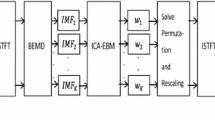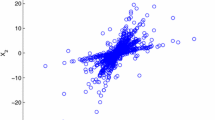Abstract
A required step to realize blind source separation of a signal is to determine the number of sources building up the mixture. Generally, the assumption of equal number of sources and mixtures is imposed which becomes invalid in single-channel mixtures. Therefore, in order to apply conventional solutions, a single-channel mixture signal can be converted into a pseudo-multi-channel signal. The empirical mode decomposition (EMD) method can be used for this purpose while revealing the hidden modes of the signal. In this paper, the number of sources building the single-channel mixture is determined based on the eigenvalue information of the intrinsic mode functions extracted by the EMD method. In this context, the method based on the ratio of adjacent eigenvalues (RAE) is shown to provide satisfactory results. Moreover, the extensions of the RAE method such as diagonal loading (DL) have been already offered for signal detection problems. However, it is presented here that the DL method may not be suitable for mixtures having more than three source signals. Accordingly, a modification combining both methods is proposed. Evaluations for various synthetic signal mixtures, real-world audio and speech samples are carried out to demonstrate the better performance of the provided method.







Similar content being viewed by others
Data availability
The Signal Separation Evaluation Campaign (SiSEC) data that support the findings of this study are available from http://sisec.inria.fr/sisec-2016/. The remaining data generated or analyzed during this study are included in this article.
References
A. Aissa-El-Bey, K. Abed-Meraim, Y. Grenier, Underdetermined blind audio source separation using modal decomposition. EURASIP J. Audio Speech Music Process. 2007, 1–15 (2007)
S. Amari, A. Cichocki, Adaptive blind signal processing-neural network approaches. Proc. IEEE 86, 2026–2048 (1998)
R. Balocchi, D. Menicucci, M. Varanini, Empirical mode decomposition to approach the problem of detecting sources from a reduced number of mixtures, in Proceedings of the 25th Annual International Conference of the IEEE EMBS (Cancun-Mexico, 2003), pp. 2443–2446
J.G.A. Barbedo, A. Lopes, P.J. Wolfe, Empirical methods to determine the number of sources in single channel musical signals. IEEE Trans. Audio Speech Lang. Process. 17, 1435–1444 (2009)
S. Beheshti, S. Sedghizadeh, Number of source signal estimation by the mean squared eigenvalue error. IEEE Trans. Signal Process. 66, 5694–5704 (2018)
P. Bofill, M. Zibulevsky, Underdetermined blind source separation using sparse representations. Signal Process. 81, 2353–2362 (2001)
J.-F. Cardoso, Blind signal separation: statistical principles. Proc. IEEE 86, 2009–2025 (1998)
S. Choi, A. Cichocki, H.-M. Park, S.-Y. Lee, Blind source separation and independent component analysis: a review. Neural Inf. Process. Lett. Rev. 6, 1–57 (2005)
P. Comon, Independent component analysis, a new concept? Signal Process. 36, 287–314 (1994)
F. Cong, A.K. Nandi, Z. He, A. Cichocki, T. Ristaniemi, Fast and effective model order selection method to determine the number of sources in a linear transformation model, in 20th European Signal Processing Conference (Romania, Bucharest, 2012), pp. 1870–1874
Z. Dong, J. Hu, B. Du, Y. He, Improvement of source number estimation method for single channel signal. PLoS ONE 11, e0164654 (2016)
B. Gao, W.L. Woo, S.S. Dlay, Single-channel source separation using EMD-subband variable regularized sparse features. IEEE Trans. Audio Speech Lang. Process. 19, 961–976 (2011)
S. Haykin, Z. Chen, The cocktail party problem. Neural Comput. 17, 1875–1902 (2005)
Z. He, A. Cichocki, S. Xie, K. Choi, Detecting the number of clusters in n-way probabilistic clustering. IEEE Trans. Pattern Anal. Mach. Intell. 32, 2006–2021 (2010)
P. He, M. Qi, G. Liu, Z. Yu, Q. Fu, An adaptive single channel EMD-TNMF blind source separation algorithm for both instantaneous and convolutive mixed signal, in IOP Conference Series: Materials Science and Engineering, Vol. 658 (2019)
N.E. Huang, Z. Shen, S.R. Long, M.L. Wu, H.H. Shih, Q. Zheng, N.C. Yen, C.C. Tung, H.H. Liu, The empirical mode decomposition and Hilbert spectrum for nonlinear and non-stationary time series analysis. Proc. R. Soc. Lond. A 454, 903–995 (1998)
A. Hyvãrinen, E. Oja, Independent component analysis: algorithms and applications. Neural Netw. 13, 411–430 (2000)
S. Kırbız, B. Günsel, Perceptually enhanced blind single-channel music source separation by non-negative matrix factorization. Digit. Signal Process. 23, 646–658 (2013)
M.K.P. Kumar, R. Kumaraswamy, Single-channel speech separation using empirical mode decomposition and multi pitch information with estimation of number of speakers. Int. J. Speech Technol. 20, 109–125 (2017)
Y. Li, S. Amari, A. Cichocki, D.W.C. Ho, S. Xie, Underdetermined blind source separation based on sparse representation. IEEE Trans. Signal Process. 54, 423–437 (2006)
A.P. Liavas, P.A. Regalia, On the behavior of information theoretic criteria for model order selection. IEEE Trans. Signal Process. 49, 1689–1695 (2001)
H.-G. Ma, Q.-B. Jiang, Z.-Q. Liu, G. Liu, Z.-Y. Ma, A novel blind source separation method for single-channel signal. Signal Process. 90, 3232–3241 (2010)
M.K.I. Molla, K. Hirose, Single-mixture audio source separation by subspace decomposition of Hilbert spectrum. IEEE Trans. Audio Speech Lang. Process. 15, 893–900 (2007)
G.R. Naik, D.K. Kumar, Determining number of independent sources in undercomplete mixture. EURASIP J. Adv. Signal Process. 2009, 1–5 (2009)
A. Ozerov, A. Liutkus, R. Badeau, G. Richard, Coding-based informed source separation: nonnegative tensor factorization approach. IEEE Trans. Audio Speech Lang. Process. 21, 1699–1712 (2013)
Q. Pan, C. Mei, N. Tian, B.W.-K. Ling, E.X. Wang, Z. Yang, An effective sources enumeration approach for single channel signal at low SNR. IEEE Access 7, 31055–31067 (2019)
G. Rilling, P. Flandrin, P. Goncalves, On empirical mode decomposition and its algorithms, in IEEE EURASIP Workshop on Nonlinear Signal and Image Processing (2003)
Signal separation evaluation campaign (SiSEC). http://sisec.inria.fr/sisec-2016/ (2016). Accessed 28 July 2020
H. Sun, J. Guo, L. Fang, Improved singular value decomposition (TopSVD) for source number estimation of low SNR in blind source separation. IEEE Access 5, 26460–26465 (2017)
E. Vincent, N. Bertin, R. Gribonval, F. Bimbot, From blind to guided audio source separation. IEEE Signal Process. Mag. 31, 107–115 (2014)
M. Wax, T. Kailath, Detection of signals by information theoretic criteria. IEEE Trans. Acoust. Speech Signal Process. 33, 387–392 (1985)
A. Weiss, A. Yeredor, Blind determination of the number of sources using distance correlation. IEEE Signal Process. Lett. 26, 828–832 (2019)
O. Yilmaz, S. Rickard, Blind separation of speech mixtures via time-frequency masking. IEEE Trans. Signal Process. 52, 1830–1847 (2004)
C. Zhang, J. Yang, Y. Lei, F. Ye, Single channel blind source separation by combining slope ensemble empirical mode decomposition and independent component analysis. J. Comput. Inf. Syst. 8, 3117–3126 (2012)
Z. Zuo, J. P. Hu, Z. P. Huang, Y. M. Zhang, Estimation of source number for single-channel received signal, in MATEC Web of Conferences, Vol. 44 (2016)
Funding
This work was supported by TÜBİTAK with project number 113E330.
Author information
Authors and Affiliations
Corresponding author
Ethics declarations
Conflict of interest
The authors declare that they have no conflict of interest.
Additional information
Publisher's Note
Springer Nature remains neutral with regard to jurisdictional claims in published maps and institutional affiliations.
Rights and permissions
About this article
Cite this article
Özbek, M.E. Determining the Number of Sources with Diagonal Unloading in Single-Channel Mixtures. Circuits Syst Signal Process 40, 5483–5499 (2021). https://doi.org/10.1007/s00034-021-01728-3
Received:
Revised:
Accepted:
Published:
Issue Date:
DOI: https://doi.org/10.1007/s00034-021-01728-3




